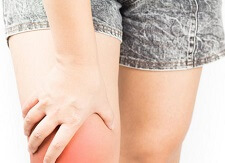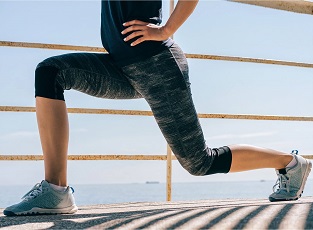- Home
- Knee Pain Diagnosis
- Swollen Knee
- Treatment
Swollen Knee Treatment: How To Reduce Knee Swelling Quickly
Written By: Chloe Wilson, BSc(Hons) Physiotherapy
Reviewed by: KPE Medical Review Board
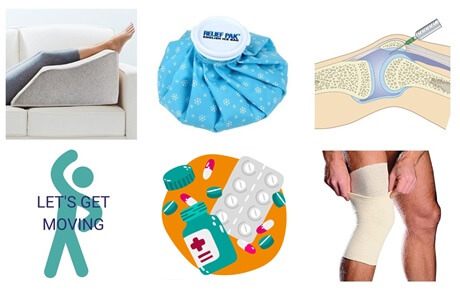
There are lots of options with swollen knee treatment that can really help to reduce knee swelling quickly.
A swollen knee is usually caused by excess fluid in or around the knee joint.
This may be due to a knee injury damaging one of the knee structures, wear and tear, an infection or an underlying medical condition. Any of these can cause knee pain and limit function.
How To Reduce Swelling In Knee Quickly
So let’s have a look at the best swollen knee joint treatment options to reduce swelling as quickly as possible, most of which can be done at home, and then we’ll go on to look at the most common causes of knee swelling.
1. Compression Bandage
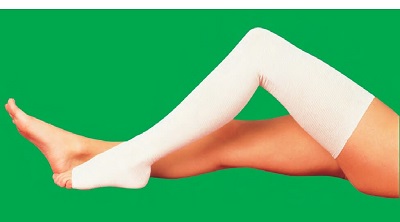
A great place to start with swollen knee treatment is to provide support and compression to the joint with a compression bandage.
The simplest and most effective way to use compression on a swollen knee is Tubigrip.
Tubigrip is a specially designed elasticated bandage. It is made up of small elastic threads that are covered in fabric. Rather than wrapping around your knee like a traditional bandage, Tubigrip is tubular which means you simply pull it on and it moulds to the shape of your knee.
Tubigrip evenly distributes pressure around the knee which helps to both push fluid out of the knee joint and stop excess fluid flooding in to the joint, which is why it is such as good swollen knee treatment tool.
How To Use Tubigrip Correctly
Get The Right Length: The key with using tubigrip to reduce knee swelling is to have a long enough piece. When using tubigrip for swollen knee treatment it should run at least from mid-thigh to mid-calf height and preferably from just below your hip to just above your ankle. It should also be worn double thickness.
So often I have seen people with a really small piece of tubigrip that only just covers the knee, and only a single layer. That is not going to do anything. The tubigrip needs to be long enough that the excess fluid is pushed away from the knee joint and back into general circulation, otherwise the fluid will just keep trying to get back into the knee. And wearing only a single layer will not provide enough compression to make much of a difference.
Choose The Right Size Tubigrip: Tubigrip is available in a range of sizes and it is important to get the right size for your knee – too tight and it will quickly be very uncomfortable, too loose and it won’t be effective. Check out our Tubigrip Size Guide to find the right one for you.
How Long Should You Wear Tubigrip: Tubigrip can be used for however long your knee swelling remains – its effectiveness doesn’t decreased with time. But you MUST take it off at night.
Top Tips: Check out the Tubigrip Compression Guide to find out everything you need to know about using tubigrip effectively for swollen knee treatment e.g. how to put tubigrip on, how to stop it rolling down and when not to wear tubigrip.
Find Out More: Tubigrip Compression Bandage >
2. Medication
There are a whole range of medications out there that can be helpful as part of swollen knee treatment.
The most popular tend to be non-steroidal anti-inflammatory drugs aka NSAIDs. NSAIDs work by blocking the enzyme cyclooxygenase from creating prostaglandins, lipids that play a key role in the inflammatory process.
Over the counter non-steroidal anti-inflammatory medications such as ibuprofen (Advil, Motrin, Neurofen) and naproxen (Aleve, Naprosyn) are popular as they are cheap, work quickly and have fewer side-effects than steroids.
But just because they are available over the counter, doesn’t mean they are for everyone. They do have potential side effects and you should always check with your doctor or pharmacist before starting any new medications.
Stronger non-steroidal anti-inflammatories may be prescribed by your doctor such as diclofenac, meloxicam and Celebrex.
#CommissionsEarned from Amazon on qualifying purchases
3. Elevation
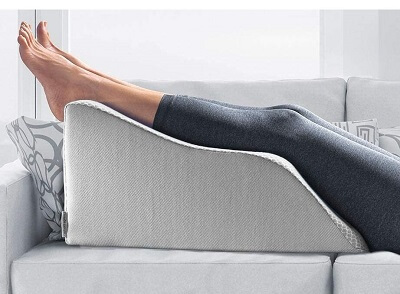
It might sound simple, but one of the best swollen knee treatments at home is to keep the leg elevated anytime you are sitting or lying down.
It all comes down to gravity as fluid will follow the path of least resistance, which is typically downwards!
If you prop a swollen knee up, higher than the level of the heart, then the excess fluid will gradually drain down away from the knee towards the hip and the heart and be reabsorbed into the lymphatic system.
Now, as long as the knee is still injured, it will continue producing more fluid so the swelling will fluctuate, getting worse the longer you are on your feet. People typically find that their knee is less swollen in the mornings and gets progressively worse during the day.
You can either prop your leg up on pillows/cushions but an even better option is to use a specially designed leg elevation cushion, which holds it shape really well, doesn't slide around and ensures you keep the leg elevated high enough.
Key things to remember when using elevation as part of your swollen knee treatment are:
- Any time you are sitting/lying down, prop your leg up
- Ideally, you want your knee to be higher than your heart
- Make sure the back of the knee is supported whilst it is propped up otherwise the knee will quickly become stiff and sore.
- Make sure your feet are level with or preferably slightly higher than your knees otherwise the fluid will likely pool around your ankles
4. Apply Ice
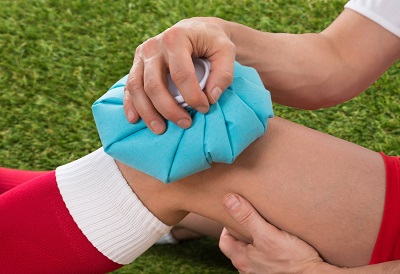
Applying ice packs regularly in the early stages after an acute knee injury is a simple and effective swollen knee treatment and a great way to quickly reduce knee swelling
Ice therapy works to reduce swelling by reducing blood flow to the knee through narrowing of the blood vessels, known as vasoconstriction.
Ice also has the added bonus that it reduces nerve activity which helps to reduce pain. So it’s definitely 2 for 1 when using ice for swollen knee treatment.
Different Methods of Applying Ice
There are loads of different ways to apply ice to your injured knee. The most popular options for applying ice are:
- Ice Cubes or Crushed Ice: No specialist equipment needed, just wrap them in a tea-towel so you don’t risk an ice burn. Top tip – put them in a sealed plastic bag so it doesn’t leak everywhere! Crushed ice has been shown to work fastest at reducing tissue temperature, but also melts quickest
- Ice Bag: a great container for ice cubes or crushed ice – much simpler than trying to wrap them in a tea-towel. And easy to wash once you’re done. Find Out More >
- Gel Ice Packs: Gel ice packs are great to have in the freezer. They are pliable so you can mould them to fit around your knee. And they are reusable. Find Out More >
- Instant Ice Packs: Perfect for taking out and about e.g. when playing sports. I now keep one in my car for when I’m out and about with my kids – they’ve come in very handy with my sporty son a number of times now! Find Out More >
- Frozen Veg: easy to apply, cheap, but less effective at reducing tissue temperature. And make sure you don’t eat them afterwards!
Getting The Best Results
Ice works best when used regularly in the first 48 hours after a knee injury.
Ice should be applied for a maximum of 10 minutes to the knee. If you leave it on any longer, you actually cool the area down too much and prevent the flow of chemicals needed for healing entering the knee which will actually delay recovery.
Leave at least 2 hours between applications to allow the circulation to return to normal.
Safety Information Don’t use ice for swollen knee treatment if you have:
- Circulatory problems
- Sensory Disorders e.g. diabetes as you may not feel it if the area gets too cold.
Find Out More: How To Safely & Effectively Use Ice Treatment >
5. Rest It Right
A crucial part of swollen knee treatment is getting the right amount of rest so that the knee has a chance to heal. The last thing you want to do is keep aggravating the joint and cause more and more swelling.
Now that’s not saying you should take to your bed and do nothing - more on that in a minute! It’s usually absolutely fine to keep walking and doing general day to day movements with a swollen knee. But if there are certain activities that aggravate your knee, lay off them for a few days. Give your knee a break. You may even need to use crutches for a few days if you are struggling to get around.
Generally the kind of activities you want to avoid with knee swelling are things like:
- Squatting
- Jumping
- Running
- Lifting heavy weights
- Kicking
Find Out More: How To Rest It Right After A Knee Injury >
6. Get The Knee Moving
So we’ve talked about how important rest is with swollen knee treatment, but on the flip side, movement is also really important too. It is a delicate balancing act between the two. Gentle knee movement is a great way to quickly reduce knee swelling.
Whilst it is important not to aggravate the knee joint as you don’t want to cause more swelling, getting the joint moving is also really important as it helps to pump away any excess fluid that has pooled in the knee joint. By gently bending and straightening the knee it places some pressure on the swelling and pushes it out of the knee.
People with a swollen knee often complain that the knee feels really tight and stiff when they first get up but that after they have been moving around for a few minutes, it eases off. That is because the movement helps to pump the excess fluid out of the knee.
So a good tip is to bend and straighten the knee a few times before you get up in the mornings or after you have been sitting down for a while so that the swelling has reduced a bit before you get up. You’ll be amazed what a difference it makes.
Once the swelling has started to go down, you can start on some gentle knee mobility exercises to further help reduce swelling and to regain full movement and mobility in your knee.
If you are keen on exercising, opt for things where you aren’t putting too much force through the knee. Cycling and swimming for example will likely be much better than running.
7. Steroid Injections
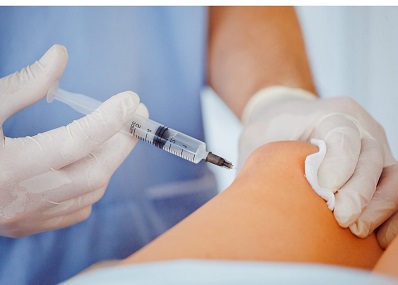
Your doctor may recommend a steroid injection as part of your swollen knee treatment.
They offer targeted, powerful, rapid relief from inflammation.
Steroid injections for knee swelling are usually a combination of:
Cortisone: a synthetic version of the hormone cortisol that suppresses the immune system. It prevents collagen production which in turn reduces inflammation
Local Anaesthetic: provides almost instant pain relief
Cortisone injections may be used for swollen knee joint treatment for conditions such as knee arthritis, or may be given into one of the knee tendons if the swelling is due to knee tendonitis.
Effects of cortisone injections for swollen knee treatment are usually felt within a few days and may last for a matter of weeks or in some cases months. Whilst steroid injections don’t always cure the underlying cause of the knee problem, they are effective in reducing pain and inflammation so tend to work best when used alongside other swollen knee treatments.
Find Out More: about the effects, uses, side effects and safety issues of steroid knee injections >
8. Aspiration
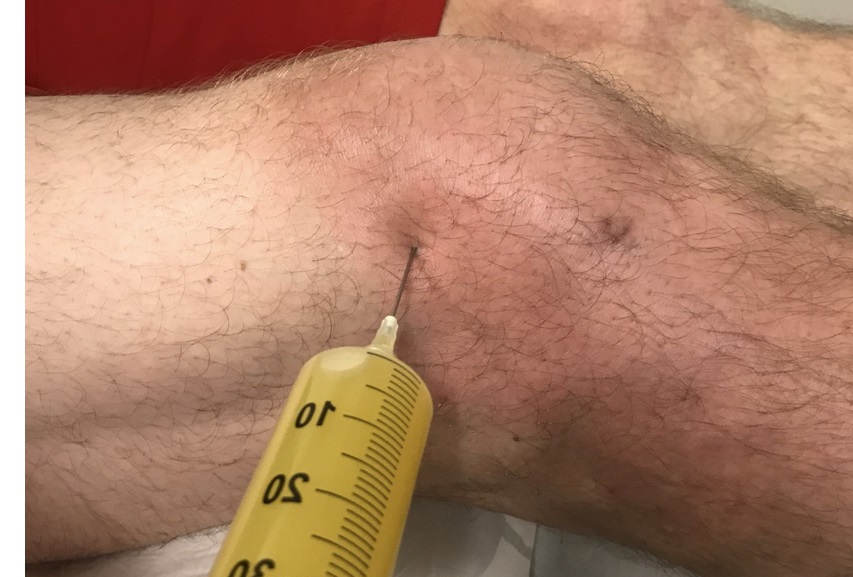
If there is a pocket of fluid in the knee joint or in one of the surrounding bursa, your doctor may be keen to drain the fluid as part of your swollen knee treatment.
Knee aspiration is done by placing a needle attached to a syringe into the knee joint or bursa and drawing out the excess fluid.
The appearance of the drained fluid will vary depending on what is causing the knee swelling:
- Clear or Straw-Colored: excess synovial fluid from joint irritation
- Red/Black: bleeding within the joint
- Cloudy: possible infection
- Contain Crystals: if there are high levels of uric acid that have formed crystals
Not only does draining the fluid reduce knee swelling, the fluid can also be sent off for analysis to provide an accurate diagnosis of the underlying knee problem. It certainly is one of the quickest ways to reduce knee swelling!
Aspiration is most typically used as part of swollen knee treatment with the following conditions
- Knee Arthritis: typically arthritis flare-up or gout knee
- Knee Bursitis: Inflammation of one of the knee bursa
- Joint Infection: e.g. septic arthritis
Aspiration is usually only a temporary swollen knee joint treatment - the underlying cause of the knee swelling needs to be addressed otherwise the fluid will just recollect in the knee.
What Causes Knee Swelling?
There are a number of different things that can cause the knee to swell that present slightly differently
- Rapid Onset Knee Swelling: Meniscus/Cartilage Tear, Ligament Tear, Fracture, Dislocation, Gout
- Gradual Onset Knee Swelling: Ligament sprain, meniscus irritation, arthritis, bursitis, tendonitis
- Hot, Swollen Knee: Gout Knee, infection, DVT
- Swelling Behind The Knee: Bakers Cyst, calf tear, DVT
- Swelling Above The Knee: Quads tear, quadriceps tendonitis, suprapatellar bursitis
- Swollen Knee Cap: Housemaids Knee
- Swelling Below The Knee Cap: Patellar Tendonitis, infrapatellar bursitis, pes anserine bursitis
How To Reduce Swelling In Knee Quickly
The best way to quickly reduce swelling in the knee is:
- Protect: the knee from further injury e.g. crutches, knee braces
- Rest: avoid any aggravating activities for a few days
- Ice: apply ice packs every 2 hours for 15 minutes
- Compression: wear tubigrip elasticated bandage
- Elevation: rest with your leg raised on a leg cushion
- Medication: anti-inflammatory medications e.g. ibuprofen
- Movement: keep the knee gently moving to pump the excess fluid out of the joint
Using a combination of these swollen knee treatments will not only help reduce the pain and swelling in your knee, but will also speed up healing and recovery.
Swollen Knee Treatment Summary
The best swollen knee treatment for you will vary depending on the underlying cause but will most likely incorporate the things we have talked about here, alongside extra things for each different knee problems.
You can find out lots more about the different causes of knee swelling and how to tell which one is affecting you in the Swollen Knee Guide.
And if you are looking for ways to reduce knee pain, check out the Knee Treatment Guide for loads of great ideas.
You may also be interested in the following articles:
- Front Knee Pain
- Inner Knee Pain
- Outer Knee Pain
- Pain Behind The Knee
- Knee Pain Diagnosis
- Knee Strengthening Exercises
- Top Tips For Doing Stairs With Knee Pain
Related Articles
References
- Summit Orthopaedics: How Do Cortisone Shots Work? Dr D. Hanson
- Healthline: Guide to Over-the-Counter (OTC) Anti-Inflammatories. March 2020
- Arthritis Health: How To Care For A Swollen Knee. July 2020
- Journal of the Royal Society of Medicine. The acute swollen knee: diagnosis and management by C. Gupte and J-P St Mart. July 2013
Page Last Updated: January 15th, 2025
Next Review Due: January 15th, 2027
